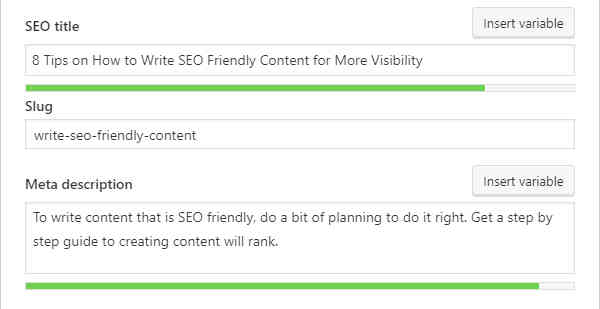With the vast amount of content being published daily, your content needs to be strategically written to help your business gain visibility. If you write well-optimized, high-quality content, you will improve your chances of ranking higher in the search results. But to write content that is SEO-friendly, you need to do a bit of planning to do it right.
First you need to know who you are writing for. What does your target audience need to help them achieve a goal or solve a problem? When you understand who your audience is, you will be able to create the right content that has value to them.
What is SEO-friendly content?
SEO-friendly content is content written to help the search engines understand what it is about and rank it appropriately. This means that not only can the search engine understand the topic of the article, it also can determine which search queries align with the topic based on the intent of the search.
The following 8 steps will help you write content that appeals to both humans and search engines.
1. Start with keyword research
When we say that all content is strategic, we mean that we need to write our content to align with what our ideal customers are searching for. Finding the right keyword phrases will help you create content that speaks to your target audience and may dominate the search results.
There are three things you need to understand about search:
- What phrases or questions people use to search
- Why they are searching in the first place
- If the phrase has multiple meanings, what the intent of the search is to them
To determine what phrases are being used when searching, there are tools you can use to find out what keywords are popular.
- Look at your Google Search Console or Bing Webmaster Tools for keywords where your website gets impressions. If there are impressions with no clicks (and the phrase is important to your business), you can add them to your list of potential content topics.
- Install the Ubersuggest or Keywords Everywhere extensions to Chrome to get variations on your keyword phrase and monthly search volumes. Again, these tools will show you many types of queries that could become part of your list of content topics.
- Use the Rank Tracker tool from SEO PowerSuite.
Next, you need to understand the reason your audience is searching – the why. By knowing the intent of the search, you can create the right content that will encourage them to read and take your desired action.
Once you come up with a list of keywords, now you can determine why your visitor is searching. Are they:
- Researching a topic to learn more?
- Comparing products for a subsequent purchase?
- Ready to make a purchase?
But remember that keywords can have multiple meanings. This is why you need to understand the searcher intent when someone uses a particular keyword phrase. This is important because if your content satisfies the needs of those searching, it will more likely turn up in the search results for that query again.
2. Get organized before you write
Some people can just dive in and write a great post. But that may not work for most of us. You need to be prepared and organized before you start writing. From your keyword research, you should have built a solid list of topics, phrases, questions and ideas for your content.
- Develop a content calendar using your topic list – always know what content you need to create
- Research before you write – eliminate disruptions that break your concentration
- Create an outline – keeps you on topic and helps the content flow more smoothly
- Eliminate distractions – block off time to write, close your email / social media sites and don’t answer the phone
Having a solid list of topics also helps you pick the one you are energized to write about. The more interesting the topic, the easier it will be to focus on researching and writing about it.
3. Write your content
Content is your first priority. It needs to be well-written, authoritative and cover the topic in depth. That doesn’t mean length or complexity. The content should directly answer the question being asked through the search query in simple terms but in a complete and comprehensive manner.
It takes some work to write compelling content. Your content should grab the attention of your reader and encourage them to take action. Write content that educates your visitors and helps them better understand the solution to their problem. Content that attracts more traffic will get more visibility and therefore, will encourage more backlinks.
Review other posts on the same topic. Make sure what you are writing is somehow different than what is already published. By different, it could be more entertaining, higher quality, more in-depth or written from a different perspective.
Write your content without thinking about editing, formatting and SEO. Worrying about making it SEO friendly while you are crafting the piece will slow you down.
4. Organize your content into short sections with headers
Now that you have your content written, let’s go back and optimize the content to make it SEO friendly and help you gain visibility.
Break your content into short sections using headlines and sub-headers. Add your keywords to your headers and sub-headers, but remember to not abuse this to game the system.
Short sections make your writing easy to skim and therefore easier to read quickly. People are more likely to share things that are easy to read.
The same goes for search engine robots. When crawling through your site, they’ll recognize your headlines and use them to better understand your content.
But make sure you use header tags for subtitles – i.e. H2, H3. Many people just bold regular text to make it stand out but you lose the value of the keyword in a header tag. And it appears as just a big wall of text.
5. Craft your title
Once you have your content written, now create a title that makes it stand out. This is usually the hardest part of writing which is why I recommend you leave it until the end. If you start with the title, you may never get to the body of the content. Plus many times, the title changes after the content is written, organized and edited.
Your title should contain your keyword phase and provide the reader information on what the value of the content will be. It should also be unique for each page or post. If you are using WordPress, your content title will naturally use the H1 heading tag.
6. Add on-page SEO
Plenty has been written about on-page SEO and its importance. But search engines look at various areas of your content when evaluating it for ranking. Make sure you at least take advantage of the following:
- Craft a keyword rich SEO title tag that catches the searchers attention
- Optimize the meta description with a call to action
- Ensure your permalink (URL) is readable and contains your keyword phrase
Yoast on-page SEO meta title and description
Keywords need to be used naturally throughout the content. Naturally means written for the human, not the search engine.
Including varying types of media in your content can make your content more interesting. Include images, video or audio to enhance user experience when it makes sense. Be sure to optimize your multimedia, especially images, by using your keywords in the filenames, adding them to the alt tags and using descriptive text to provide context. Also use your keyword in the page URL.
7. Link to existing content
Add links to your existing content when they are related. This shows that you are the authority on this topic and can cover it from many different angles. In addition, these links also help the search engines understand the relationships between your various pieces of content.
Also add links to external content that supports your topic and can be helpful to the reader. A link to a great blog post that complements yours adds to your credibility because it gives readers a broader perspective. When you share and link to others, you are seen as a hub of your network. Pick external content carefully though. Make sure what you link to is high quality and worth the backlink.
Writing quality content that gets you found will take some time to create, but it is extremely worthwhile. Keep it simple and implement these basic techniques. Understand your audience’s needs and how they search for solutions. Then you will be able to write SEO-friendly content that appeals and attracts them to your business.

